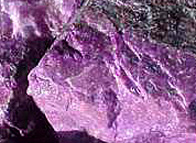
Named for Professor Ken-ichi Sugi, who discovered the mineral in a non-gem form in Japan in 1944, the first gem grade, commercially exploitable deposits were not found until 1979 in the Wessels' Mine area of the South African Kuruman manganese fields.
Although pure Sugilite, a complex silicate which gets its purple color from manganese, is a mineral species, much of the more variously colored material commonly cut into cabochons, and called Sugilite is technically a rock composed of both Sugilite and chalcedony. Sugilite was formed in deep beds of manganese-containing metamorpic rocks that were later invaded by silica rich hydrothermal fluids.

Sugilite occurs as a microcrystalline aggregate and ranges in color from dark to medium purple, with variable amounts of dark or light mottling when chalcedony is present. Although a small percentage of the rough is translucent, most pieces seen on the market are opaque. The pure purple specimens which are nearly 100% Sugilite are 5 1/2 - 6 in hardness, while the pieces containing chalcedony may be 6 1/2 or higher and often have a more reddish purple color and/or distinctive patterning.


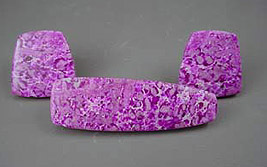
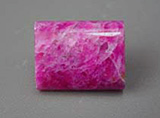
This beautiful purple gem was discovered during mining operations for manganese in the 1970's, but it didn't begin to make a market impact until the 1980's. It is expensive as opaque stones go, even though the known deposit is quite large, this is primarily because the one and only source is remote (in the Kalahari Desert near Botswana), and it must be mined 3200 feet underground. I have no doubt that it would be buried still, if it were not a profitable sideline of on-going industrial manganese mining.
In the early 80's, attempts were made to market Sugilite under various tradenames such as "Royal Azel", "Wesselite" and "Lavulite", but none of these caught on. The translucent, dark purple (grape jelly) pieces are referred to as "gel Sugilite" and are very expensive due to their rarity. It's estimated that less than .05% of the gems mined from the deposit are in this gel form. The gem has recently received a boost in popularity, though, as have many unfamiliar opaque gems, via the home shopping channels and internet auctions sites which feature them in sterling silver jewelry.
There are no known enhancements of this gem and it has not been synthesized. However, a plastic "Sugilite" simulant is sometimes used in inexpensive jewelry pieces. Plastic will melt and give off an acrid smoke when touched with the tip of a red hot needle, Sugilite will not react.
Athough reasonable care should be taken in setting and wearing this gem, it is relatively durable compared to some other popular cabochon gems. Sugilite is, for example, less susceptible to chemical attack than turquoise, and less sensitive to heat and drying than opal. It will need a repolishing from time to time if worn daily in a ring, and it should be protected from sharp knocks, but otherwise it is highly suitable for most jewelry uses.
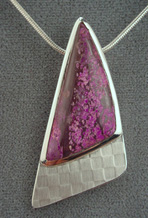
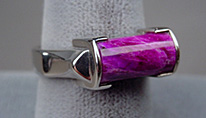
The major value points are the depth and purity of the purple color and the degree of translucence. Within the opaque type, those which are the richest and purest purple color (without appearing black) and least mottled are the most valuable. It is the translucent "gel" form that commands the highest prices -- the very best pieces of which are generally set in gold and surrounded by diamonds . When pieces are mottled, particularly attractive patterns can rise above the norm in value, as is the case, for example, with the spotted "leopardskin" Sugilite.
Makeup: a complex silicate colored by manganese, often mixed with chalcedony (quartz)
Hardness: 5 1/2 - 6 if pure, 6-6 1/2 if mixed with chalcedony
Crystal structure: hexagonal
Cleavage: none
Density: 2.74
RI: 1.60-1.61 if pure, can be as low as 1.54 from chalcedony present
Birefringence: .003
Pleochroism: none